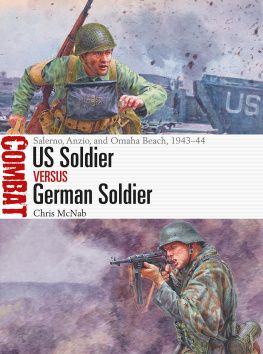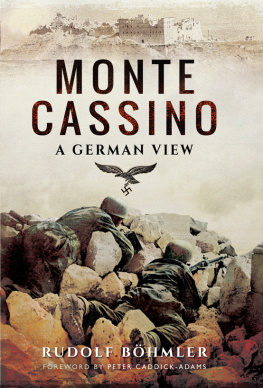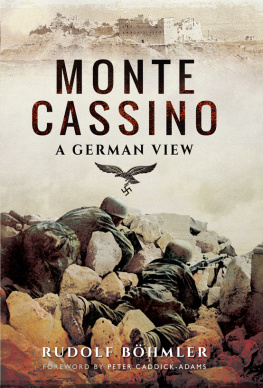IMAGES OF WAR
ON TO ROME
ANZIO & VICTORY AT CASSINO, 1944
RARE PHOTOGRAPHS FROM WARTIME ARCHIVES
Jon Diamond
First published in Great Britain in 2018 by
PEN & SWORD MILITARY
An imprint of
Pen & Sword Books Ltd
47 Church Street
Barnsley
South Yorkshire
S70 2AS
Copyright Jon Diamond, 2018
ISBN 978-1-52673-253-8
eISBN 978-1-52673-254-5
Mobi ISBN 978-1-52673-255-2
The right of Jon Diamond to be identified as author of this work has been asserted by him in
accordance with the Copyright, Designs and Patents Act 1988.
A CIP catalogue record for this book is available from the British Library.
All rights reserved. No part of this book may be reproduced or transmitted in any form or by any means, electronic or mechanical including photocopying, recording or by any information storage and retrieval system, without permission from the Publisher in writing.
Pen & Sword Books Limited incorporates the imprints of Atlas, Archaeology, Aviation, Discovery, Family History, Fiction, History, Maritime, Military, Military Classics, Politics, Select, Transport, True Crime, Air World, Frontline Publishing, Leo Cooper, Remember When, Seaforth Publishing, The Praetorian Press, Wharncliffe Local History, Wharncliffe Transport, Wharncliffe True Crime and White Owl.
For a complete list of Pen & Sword titles please contact
PEN & SWORD BOOKS LIMITED
47 Church Street, Barnsley, South Yorkshire S70 2AS, England
E-mail:
Website: www.pen-and-sword.co.uk
Contents
Acknowledgements
T his archival photograph volume in the Images of War series is dedicated to the men and women who fought and perished in southern and central Italy during the early autumn of 1943 and extending well into 1944 to wrest control of the Italian mainland from the Nazis. We ponder upon viewing the photographs about the heroic sacrifice made to maintain freedom lest we forget. The author also wishes to acknowledge the many military history scholars, past and present, including such names as Blumenson, Graham, Bidwell, DEste, Ellis, Neillands, Strawson, Konstam, Zaloga, Ford, Clark, Atkinson and Whitlock, to name but a few, who have catalogued the nuances of this protracted campaign with their superlative prose. The author is indebted to the able assistance of the archivists at both the United States Army Military History Institute (USAMHI) at the United States Army War College in Carlisle, Pennsylvania, and the Still Photo Section of the National Archives and Records Administration (NARA) in College Park, Maryland.
Chapter One
Strategic Prelude to the Campaign for Rome
A stalemate had developed along the Nazi defensive Gustav Line to the south of Rome during early February 1944, particularly at the town of Cassino, situated across the Rapido River, with the towering Benedictine abbey looming above overlooking the Liri Valley and the pathway to Rome. British prime minister Winston Churchill desperately wanted to capture the Eternal City, despite Italys capitulation to become an Allied co-belligerent.
Before the battles for Rome, a series of see-saw campaigns (the Benghazi Handicap) pitted General Archibald Wavells Western Desert Force (later to become, first, British XIII Corps and then Eighth Army under General Claude Auchinleck) and the Axis in the Cyrenaican third of Libya from December 1940 through to August 1942. Then, the British Eighth Army, under Lieutenant-General Bernard Montgomery, won the decisive Second Battle of El Alamein in November 1942 and commenced the pursuit of German Field-Marshal Erwin Rommels GermanItalian PanzerArmee Afrika across the Libyan Desert into south-eastern Tunisia. Coincident with this was Operation Torch, the Allied invasion of French north-west Africa near Casablanca, Oran and Algiers in Morocco and Algeria. After the rapid capitulation of Vichy French forces there, six months of bloody Tunisian combat ensued with the ultimate surrender of Axis bridgeheads in Bizerte and Tunis in early May 1943. With the Allied commander, General Dwight Eisenhower, having amassed a large expeditionary force in North Africa, along with Churchills zeal to knock Italy out of the war and tie down German formations along Europes soft underbelly, Sicily was invaded on 10 July 1943 during Operation Husky. The Allied Seventh and Eighth Armies, under the command of Lieutenant-General George Patton, and Montgomery, respectively, required thirty-eight days to force a tenacious Axis foe to evacuate the island to the Italian mainland across the Strait of Messina on 17 August. Benito Mussolini had been ousted in late July, and on 8 September the Italian government capitulated, precipitating a Nazi seizure of Italy. On 3 September Eighth Armys British XIII Corps staged the uncontested Operation Baytown and seized many locales along the Calabrian toe of Italy, while elements of the British 1st Airborne Division amphibiously landed at Taranto, Operation Slapstick, along the peninsulas heel on 9 September.
On 9 September, a larger Allied amphibious assault landed Lieutenant-General Mark Clarks Fifth Armys British X and US VI Corps along the Gulf of Salerno, to Naples south. Initial attempts by only the German 16th Panzer Division failed to dislodge the Allies from their beachheads. However, within days, German Tenth Army commander General Heinrich von Vietinghoff amassed the XIV and LXXVI Panzer Corps and struck the Allied perimeter, almost compelling Clarks evacuation of the US VI Corps from the battlefields southern end and re-situating it in British X Corps northern sector. On 18 September, Vietinghoff withdrew his Nazi divisions to a temporary defensive line along the Volturno River, north of Naples. The Allies entered the Neapolitan port on 1 October and began extensive repair of the Germandemolished dock facilities. German Field-Marshal Albert Kesselring, commanding the Nazi forces in southern Italy, ordered Vietinghoff to hold the Volturno River line until 15 October, enabling the completion of the more temporary Barbara and Bernhardt Lines, while more substantive fortifications were erected on the Gustav Line, which ran along the Garigliano and Rapido Rivers, stretching from the Tyrrhenian Sea in the west to north of the Sangro Rivers mouth on the Adriatic Sea coast in the east.
While Montgomerys Eighth Army units battled to the east of the Apennine Mountain spine at such locales as Fossacesia, Mozzogrogna, Orsogna and Ortona, Clarks Fifth Army campaigned in a wet, cold climate amid the massif comprising the pillars of the Mignano Gap, in an attempt to gain entry into the Liri Valley to the south of Cassino and then on to Rome. After Clarks disastrous attempt to cross the Rapido River in front of Cassino with his US 36th Division ended in failure on 2022 January 1944, his II Corps reinforced US 34th Division, along with the French Expeditionary Corps (FEC), the latter under the capable French general Alphonse Juin, almost seized the Benedictine abbey and Monte Cassino during the early days of February. However, their attacks faltered amid a determined Nazi resistance and Allied exhaustion, as the II New Zealand Corps was held in reserve rather than committed to the tail-end of the hard-pressed Allied mountain attack north of the town. The First Battle of Cassino ended with the Germans in possession of the town, the heights and the monastery looming above.
Next page













